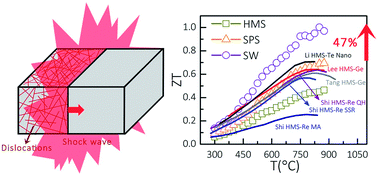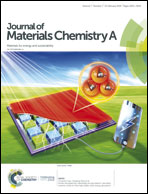Enhanced thermoelectric performance of higher manganese silicides by shock-induced high-density dislocations†
Abstract
Minimization of the lattice thermal conductivity (κL) in thermoelectric (TE) materials is a widely applied strategy to improve the thermoelectric performance of these materials. Dislocations have been demonstrated to be effective in scattering the mid-frequency phonons, which can dramatically reduce the κL in combination with the nanostructures and point defects. Generally, plastic deformation is the most straightforward method to generate dislocations in an alloy. However, most TE materials cannot readily deform plastically due to their brittleness. Herein, we have demonstrated that shock compression is effective in generating high-density dislocations (∼7.9 × 1012 cm−2) in TE materials. Shock compression is an extreme regime of deformation with ultra-high strain rates (>106 s−1) and high pressures (∼GPa), combined with high temperatures during the process. Using this method, multi-scale hierarchical architectures were fabricated in higher manganese silicides (HMS) with nano-sized grains and high-density dislocations. An ultralow lattice thermal conductivity of 1.5 W m−1 K−1 has been achieved in HMS compounds, and the maximum ZT is increased by 47% to 1.0, which is higher than that of most of the ZT values reported for the HMS compounds. These results demonstrate that dense dislocations not only can lower the κL and improve the ZT of HMS, but can also extend the application of the shock compression method to the design of advanced TE materials.



 Please wait while we load your content...
Please wait while we load your content...